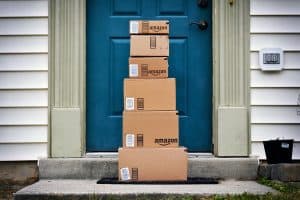How to Adapt to the Growing Influx of Online Deliveries at Your Apartment Community

Property managers that have accepted, signed for, and held resident packages are now struggling to handle the growing popularity of online deliveries. With 41 percent of Americans receiving two to five packages every month, property management companies have taken on the role of community delivery centers, which can be a taxing duty for staff to handle. In fact, a recent survey conducted by the National Multifamily Housing Council found that the typical building or complex receives up to 100 packages a week, which takes property staff up to five hours each week to sort and process.
To combat this delivery issue, some businesses have stopped offering package receiving services altogether. For example, three years ago, Camden Property Trust, then the 14th-largest multifamily housing business in the U.S., halted the acceptance of packages on behalf of their residents at every one of their 169 properties after receiving almost one million parcels in a single year. The company’s analysis estimated that each package resulted in ten minutes of lost productivity for staff, costing 3.3 million dollars in annual employee wages. But while the costs of traditional package receiving policies are becoming costly for multifamily properties, the growing trend of online purchases isn’t slowing down anytime soon. The 2017 holiday season saw record-setting numbers of online sales with Americans buying 3.07 billion dollars of goods on “Cyber Monday” alone, and the number of U.S. packages shipped soared in tandem with those online purchases.
With these rising numbers of shipments, the demand for safe package acceptance services has also become a top priority for today’s renters. This is due to the vulnerability of packages in the online purchasing and shipping process. E-commerce has led to a rise in package theft—nearly one in three Americans have reported getting a package stolen, and 35 percent of consumers are reluctant to get packages delivered to their homes due to this growing concern.
So, while traditional delivery policies are overwhelming property managers, doing away with the service altogether may prove to be an unattractive solution to this issue. Multiple surveys in the last year illustrate that package acceptance services rank among the top ten amenities that renters seek when searching for an apartment home. Luckily enough for multifamily housing professionals, there are new services available that are designed to aid property managers attempting to manage this 21st-century phenomenon. With delivery services poised to become a crucial concern for today’s renters, these solutions have the potential to become a marketable and even a profitable amenity.
In the past five years, multiple property management companies have invested in innovative, electronically-operated lockers for their multifamily communities. These receiving systems have successfully gained traction in the market as both property managers and renters seek solutions, but none have been as successful as Amazon.
Just last year, Amazon signed contracts with multifamily property owners and managers for more than 850,000 apartments in the U.S. to install “Amazon Hubs,” the company’s delivery locker service that ensures safe package delivery. The lockers are electronically controlled and only accessible to apartment residents, who receive a text or e-mail notification when a package arrives as well as a code that allows them to open their assigned locker slot and retrieve their parcel.
The Hub service marks a milestone development for Amazon’s locker service, which was previously only available for commercial businesses, in addition to only being utilized for Amazon purchases. But the multifamily-focused Hub is able to receive packages from major carriers including FedEx, UPS, and the U.S. Postal Service, and the electronic interface takes the burden of sorting and storing deliveries off property managers. The system creates efficiencies for mail carriers as well, providing a central delivery location to deposit packages instead of multiple doorsteps, which translates into quicker deliveries. Best of all, residents no longer need to worry about package theft, missed deliveries, or rushing home before the management office closes to pick-up an important package.
Amazon Hub costs apartment owners between $10,000 and $20,000, but most property management companies currently signed up for Amazon Hub do not plan to charge residents for the service. There are no additional monthly fees for properties to host a Hub, and with the savings on staff labor that the service provides and its appeal to modern, mobile renters, offering Amazon Hub as a community amenity could prove to be a valuable selling point for your property.
While traditional package receiving policies have become troublesome for multifamily housing properties, it is important to continue to offer this attractive (and even vital) service in the Digital Age. Doing away with package receiving services altogether can negatively impact your occupancy levels as renters seek amenities and services that complement their contemporary lifestyle. With online shopping quickly becoming the new norm for today’s consumers, offering modern package management solutions can be as useful to your staff’s workflow as it is to your business’s modern appeal and overall resident satisfaction.
Source: multifamilybiz.com















 Accessibility
Accessibility